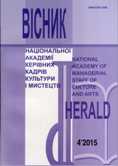ВИКОРИСТАННЯ ІННОВАЦІЙ У МИСТЕЦЬКИХ ПРАКТИКАХ СУЧАСНОСТІ
The using of innovations in art practice of modernity
Author(s): Alexander Petrovich TsugorkaSubject(s): Theatre, Dance, Performing Arts, Media studies, Music, Recent History (1900 till today), Sociology of Culture, Film / Cinema / Cinematography
Published by: Національна академія керівних кадрів культури і мистецтв
Keywords: innovations; computer and Internet technology; interactivity, virtual; network art;
Summary/Abstract: In the article the main aspects of using of innovations in art practices of modernity are analyzed. The author pays attention to the art of theatre, particularly its visualization, cinematography and electronic music. It is underlined that the important peculiarity of the modern art is the openness and its ability to combine the traditions with innovations.In the research the most attention is paid to interactivity of modern art as a means of active influence of a consumer of the fine culture on artistic work of art in specific spatial mode.However, the modern researchers of interactive art can not articulate a clear understanding and basic characteristics of this phenomenon. According to R. Ascot, an English art critic, researcher of innovative trends in contemporary art, the scientists tightly approached to the right understanding only in 1989 when the magazine "Kunstforum" and festival "ArsElectronica" attempted to understand the new artistic direction, and, as it turned out later, "finally and irrevocably brought him into the canon of Western art."Let’s consider more properly the features of the using of communication and computer innovations in modern network art. It is the most important feature of forming of a new space such as cyberculture.In the theater the virtual technologies have manifested the most clearly. An interesting art idea was the idea of virtual theater, which, at first glance, it is not so new as its author is considered to be A. Artaud, a prominent French film director and theatrical critic.In the 90-es of the XX century, The Research Institute of Virtual Realities of Kansas University implemented a series of performances using virtual realityIn 2010 S. Bezrukov, the People's Artist of Russia, launched a new project supported by STD – Russia's first internet-theater "Free Platform". Certainly, we provide various examples of internet technologies in theater, which show us a single thought that the Internet theatre is needed, at least, as a mean of communication. In addition, playwrights often include its ability to plot points, for example, Internet dialogues and other things are projected on theatre backdrops.The use of digital special effects has become a selected story in cinematography and was greatly realized in the movie "Terminator 2" (1991), which won the award for best sound and visual effects. Thus, D. Cameron’s film after "The Abyss" won the director award for "Oscar" for best visual effects again.The popularity of the latest computer technology is evidenced by the fact that all the films of "Star Wars" of the director not only gained the "Oscar" for best visual effects, but also it is planning to translate (all 6 episodes) in the 3D-measurement. Of course, we cannot mention the most recent movie box office of D. Cameron – "Avatar", the creation of which began in the mid of the 90-s.Digital technology has significantly affected the modern music, which also requires today the impact of interactive response from the audience. Thanks to the "digital" e-culture has arisen ("drum'n'bass", "chaos", "easy", "techno"), which has been leading in the non-academic music for four decades.The illustrative example of the combination of tradition and innovation is the admiration of the traditional Ukrainian culture of Oleg Skrupka, a leader of the rock band "Vopli Vydoplyasova". Oleg Skrupka combines folklore groups and rock bands, working with Ukrainian folk material (especially "VV", "Mandry", "Karpatiyans").At first glance, innovative art forms, using all means and possibilities of cyberculture, have just been opposed to traditional art. However, we can see the bucking trend due to the innovations the modern art has become more opened, and therefore it should to develop in the context of artistic quest as traditional as new – and to interact with them.Therefore, we can say that traditions of innovations in the artistic culture manifested in a close relationship, sometimes even promoting creative research to combine artists from different artistic fields, is becoming an important factor in developing its creative expression in the present. This analysis of modern relationships of innovative technologies with art, including theater, cinema, music, shows us that the artistic and aesthetic potential of new technologies are discovered partially. It allows us to say about inventions of new artistic practices in the near future.
Journal: Вісник Національної академії керівних кадрів культури і мистецтв
- Issue Year: 2015
- Issue No: 4
- Page Range: 92-97
- Page Count: 6
- Language: Ukrainian

